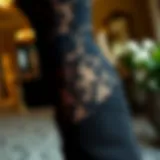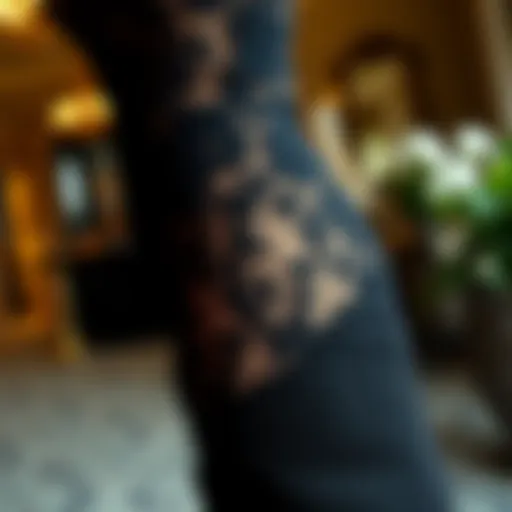Exploring the Allure of Vintage Long Dresses in Fashion
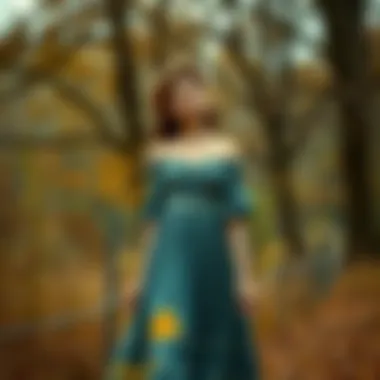

Intro
Vintage long dresses embody a sartorial charm that transcends mere fabric and thread. They tell stories of bygone eras, reflecting a rich tapestry of culture, style, and history. In a world increasingly leaning towards rapid fashion cycles, the allure of these timeless pieces remains undiminished. Understanding the journey of vintage long dresses offers not only a glimpse into fashion's evolution but also provides insights into sustainability, self-expression, and personal style.
As we venture into the depths of vintage long dresses, we’ll explore their captivating history, distinct styles, and the significant role they play in today’s wardrobe. You might find that these dresses are more than just clothing; they are a bridge between generations and a testament to the enduring nature of style.
With each section, let’s strip away the layers of modern fashion trends to unearth the wisdom hidden in vintage fabrics, and how these dresses can weave seamlessly into contemporary lifestyles. This exploration isn’t just for the avid collector or the seasoned stylist; it invites all fashion enthusiasts curious about integrating the timeless allure of vintage long dresses into their own lives.
Prelims to Vintage Long Dresses
In the realm of fashion, vintage long dresses hold a unique charm, resonating with individuals who appreciate the stories woven into every thread and the artistry that transcends time. These garments are not merely fabric stitched together; they embody eras long past, encapsulating both cultural and aesthetic identities that speak to the history and evolution of dressmaking.
Why Vintage Long Dresses Matter
At their core, vintage long dresses serve an essential role for enthusiasts and collectors alike. Their importance goes beyond mere nostalgia. Each piece transports the wearer into a different chapter of style, prompting a connection to the past that is often lost in modernity's fast-paced world. Vintage pieces invite a slower, more intentional approach to fashion — an appreciation for craftsmanship over mass production.
The charm of vintage long dresses often lies in their distinctive qualities. These clothes possess character that is hard to find in contemporary fashion. Think about how textile technology has evolved; many vintage dresses are crafted from materials that have long been abandoned, emphasizing a tactile experience that modern synthetics cannot replicate.
Benefits of Embracing Vintage Long Dresses
- Sustainability: Stalwarts of sustainable fashion, vintage dresses offer an eco-friendly alternative to new clothing, minimizing waste. Choosing vintage cloth means less strain on the planet.
- Unique Style: Wearing a vintage dress often means sporting something one-of-a-kind. These dresses stand apart from mainstream fashion, allowing individuality to shine through.
- Historical Significance: Each vintage piece tells a story, representing the styles, fabrics, and trends of its time. Understanding these nuances adds depth to the clothing worn today.
Considerations When Approaching Vintage Fashion
However, diving into the world of vintage long dresses comes with its own set of considerations. Knowledge of sizing can be tricky; the fit can vary widely between eras and manufacturers. Moreover, knowing how to care for these delicate fabrics is crucial, as improper handling can lead to irreversible damage.
The Historical Context of Vintage Fashion
Understanding the historical backdrop of vintage fashion isn’t just a matter of dates and names; it paints a vivid picture of society’s evolution. Fashion, much like art, reflects the journey of humanity through the decades, enshrining the cultural movements, technological advancements, and social changes of each era. The significance of this topic lies in how it resonates with today’s fashion enthusiasts, designers, and retailers, providing context for the choices we make in our wardrobes now. Delving into this history allows for a deeper connection with the garments we cherish and inspires thoughtful consumption.
Defining Vintage in Fashion Terms
When we talk about vintage in fashion, it’s essential to slice through some of the confusion surrounding the term. Vintage isn’t simply a catchword tossed around at thrift stores. It specifically refers to clothing that is at least 20 years old, often reflecting trends that have since ebbed and flowed. The charm of vintage pieces lies in their imperfections; each scratch or worn seam tells a story.
In a world where fast fashion reigns supreme, understanding what vintage truly means underscores its value. Consider the following aspects:
- Authenticity: Vintage clothes are often made with care in eras when fast production wasn’t the norm. Garments from the 1960s through the 1980s showcase craftsmanship that mass-produced items today rarely replicate.
- Cultural Resonance: Each vintage dress carries whispers of the past. A flowing floral number from the 70s? It breathes the free-spirited air of that decade’s counterculture.
- Investment: More than a mere trend, investing in vintage can be financially prudent. Well-crafted pieces can appreciate over time, making them not just wearable art, but also potential heirlooms.
By defining what vintage truly represents, we ground ourselves in a lineage that connects us to previous generations. It’s a celebration of uniqueness, allowing individuals to express their identity through pieces that transcend transient trends.
Evolution of the Long Dress Over the Decades
The long dress is a timeless silhouette that has traced the tapestry of women’s fashion from delicate tea-length styles to sweeping maxi gowns. Each decade has brought forth its interpretations, mirroring societal shifts and changing aesthetics.
1920s
In the roaring twenties, the long dress began its evolution into modern fashion. Flapper styles embraced looser fits and shorter hem lines; however, many women still cherished the elegant floor-length dresses for evening wear. These gowns often featured intricate beadwork and luxurious fabrics, serving as symbols of status and elegance.
1940s-1950s
With the advent of World War II, practicality took precedence but style never waned. Post-war fashion saw the introduction of the iconic New Look by Christian Dior, characterized by a nipped waist and full skirts that epitomized femininity. Long dresses during this time exuded glamour, as women sought to reclaim their identities through fashion amidst the chaos of conflict.
1960s-1970s
As the counterculture movement gained momentum in the 60s, long dresses evolved into canvas for self-expression. Maxi dresses became synonymous with the bohemian ethos of freedom, often adorned with bold prints, flowing fabrics, and relaxed fits. This was a period of rebellion against convention, and the long dress played an integral role in the movement.
1980s-1990s
With the rise of power dressing in the 80s, long dresses took on a more structured silhouette, often paired with shoulder pads and sharp lines. As the 1990s rolled in, designers embraced minimalism, leading to black and neutral-colored long dresses that were both versatile and chic.
2000s and Beyond
The turn of the millennium saw a revival of past trends, blending vintage aesthetics with contemporary style. Long dresses surged again in popularity, often inspired by the earlier decades but with modern twists—from bold fashion statements to more relaxed beachy vibes. Fashion influencers on social media have reignited the love for vintage long dresses, showcasing them in ways that resonate with younger generations.
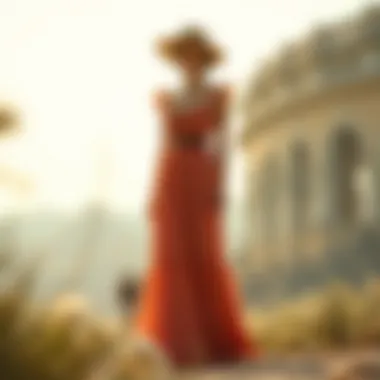

Characteristics of Vintage Long Dresses
Understanding the characteristics of vintage long dresses is like peeling an onion—layer after layer reveals historical context, social nuance, and undeniable beauty. These dresses are not merely garments; they encapsulate stories, evoke emotions, and provide a bridge connecting past and present fashion sensibilities. By examining their distinguishing traits, enthusiasts can appreciate not just how they look, but why they possess a captivating allure.
Fabric Choices: The Textiles of the Past
The fabric is the soul of any garment, and vintage long dresses are no exception. The textiles commonly found in these dresses often showcase craftsmanship that modern fashion sometimes overlooks. Many vintage dresses feature natural fibers like silk, cotton, and linen, which offer breathability and comfort that synthetic materials lack.
Consider the luxurious feel of a silk chiffon gown from the 1970s. It's delicate yet structured, perfect for an evening out or a garden party. On the flip side, vintage cotton prints echo a more casual aesthetic, often vibrant in color, and are a nod to the whimsical charm of the 1960s. Each fabric tells a tale—of materials that move with grace and style.
Highlights of vintage fabrics include:
- Silk: Associated with luxury and elegance.
- Cotton: Breathable and available in myriad prints, ideal for summer dresses.
- Linen: Known for its durability, great for a laid-back vintage look.
- Velvet: Particularly in evening wear, lends a rich texture and depth.
The choice of fabric affects not just appearance but also how the dress interacts with the wearer's body. Good vintage dresses often fit as if tailored for the person, rather than merely hanging loosely. People find joy in this tailored luxury, feeling confident and stylish.
Cut and Silhouette: Timeless Designs
The cut and silhouette of vintage long dresses are paramount in separating the wheat from the chaff. While trends come and go, certain designs remain evergreen. The silhouette of a vintage dress can dramatically shape how one carries themselves.
A prominent example is the A-line silhouette. This timeless style flatters a variety of body shapes, offering elegance while allowing freedom of movement. Then there’s the fit-and-flare silhouette, known for its ability to cinch at the waist while flaring out dramatically—ideal for creating a stylish hourglass figure.
Vintage long dresses often come with the hallmark features such as flutter sleeves, empire waists, and tea-length hems, which all contribute to a unique character that many modern pieces might lack. Each cut not only enhances the wearer’s shape but often reflects the prevailing style of its era—echoing the societal attitudes of the time.
"In fashion, the silhouette tells a tale, one that transcends time and speaks to the heart of everyone who wears it."
Patterns and Prints: A Look into Design Trends
Patterns are where vintage long dresses reveal their personality. The designs from different eras are distinctive, often reflective of cultural movements and artistic trends. From the psychedelic prints of the 60s to the delicate floral patterns of the 50s, each pattern carries its unique historical narrative.
- Floral Prints: Commonly seen in dresses from the 1940s and 1950s, they evoke feelings of romance and nostalgic warmth.
- Geometric Patterns: A signature of the swinging 60s, these designs add an element of fun, daring wearers to express individuality.
- Polka Dots and Stripes: Timeless classics, these patterns can transition from playful afternoons to elegant evenings effortlessly.
The incorporation of these patterns allows individuals to flirt with different aesthetic styles without needing a plethora of clothing. Almost every vintage dress serves as a statement piece and encourages wearers to explore and express their identities.
In summation, the allure of vintage long dresses lies in their unique combination of fabric, cut, and patterns. Each characteristic appeals to a diverse range of styles and preferences, making vintage dresses not just a clothing option but a cherished choice for those who desire both quality and individuality in their wardrobe.
Cultural Importance of Vintage Long Dresses
Vintage long dresses are more than just pieces of fabric; they encapsulate the essence of eras gone by and weave narratives of identity, rebellion, and heritage. From the grand ballrooms of the 1920s to the bohemian festivals of the 1970s, these dresses have been worn by those seeking to express individuality and societal values. This cultural significance transcends mere aesthetics; it speaks to the very heart of personal and communal stories.
The allure of vintage fashion lies in its ability to tell a tale that is rich in context. Each dress can reflect the zeitgeist of its time, embodying the aspirations and struggles of those who wore them. For instance, during the Great Depression, simpler styles emerged that prioritized functionality without sacrificing elegance, indicating a societal shift towards practicality. Meanwhile, the flamboyant gowns of the 1960s echoed a cultural revolution, as women began to embrace freedom and challenge traditional norms. Thus, vintage long dresses are emblematic of the various movements that have shaped each generation's social fabric.
Vintage clothing has the power to connect individuals not just to their own past but also to the rich, historical tapestry of society.
Vintage Dresses and Gender Expression
One critical aspect of vintage long dresses is their role in gender expression. Historically, clothing has been a significant marker of gender norms. For women, dresses have often signified femininity, grace, and decorum. However, vintage dresses also offer a space for subverting these conventions.
Take, for example, the 1940s, where utility dresses became prevalent during World War II. Women donned these practical yet stylish garments while taking on roles typically reserved for men, such as factory work and leadership positions. This shift demonstrated that dresses could symbolize empowerment rather than oppression.
In contemporary society, vintage long dresses empower individuals to challenge traditional gender roles. They encourage self-expression, allowing wearers to convey their identity through fabric, patterns, and cuts. Whether it’s the flowing lines of a maxi dress or the structured elegance of a sheath gown, each piece narrates different facets of gender expression, welcoming those from all walks of life to share their story.
The Role of Vintage Fashion in Subcultures
Vintage fashion has also played a critical role in the formation and evolution of various subcultures. Each subculture often adopts distinct fashion styles that serve to differentiate members from the mainstream, including the colorful, quirky elements found in vintage long dresses.
For instance, during the punk movement of the late 1970s, individuals often repurposed vintage clothing to project a defiant attitude towards societal norms. Dresses that had once belonged to another era were decimated and reimagined, indicating a rejection of conformity. The thrift shop finds transformed into powerful statements, illustrating how vintage fashion can not only reflect personal style but also serve as defiance against established norms.
Moreover, subcultures such as goth or bohemian have embraced vintage long dresses to signify rebellion and individuality. The rich textures and unique patterns serve as badges of identity, conveying values and aesthetics that go against societal expectations.
The Rise of Vintage Fashion in Modern Times
With the fast-paced nature of contemporary clothing trends, the emergence of vintage fashion has piqued interest across various demographics. Just as a well-aged wine begins to show its depth and character, so too does vintage attire gain value and allure over time. Many fashion enthusiasts and conscious consumers are finding that vintage long dresses are not just aesthetically pleasing; they represent a more sustainable choice in the world of fashion.
Sustainable Fashion: Vintage as an Ethical Choice
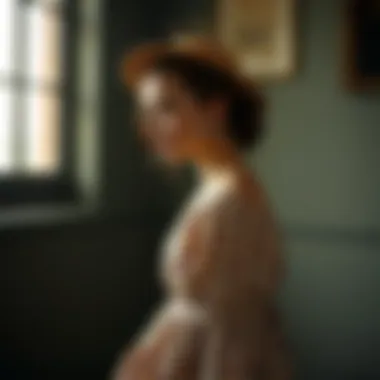

The modern consumer is more aware than ever about the ramifications of their purchasing decisions, particularly within the fashion industry. The concept of sustainable fashion has gained traction, advocating for eco-friendly practices and a shift away from mass-produced garments. Vintage long dresses are at the forefront of this movement.
By opting for vintage attire, shoppers are embracing garments that have already been manufactured, thus extending the life cycle of these pieces and reducing the need for new production. This not only conserves resources but also diminishes the environmental impact often associated with the fast fashion industry. Wearing vintage allows individuals to wear unique pieces while making a statement against wastefulness.
In fact, the charm of vintage clothing lies in its story. Each dress carries with it the echoes of time and the artistry of fashion eras long gone. By restoring and showcasing these items, individuals participate in a narrative that transcends the fleeting trends of today.
Resurgence of Retro Aesthetics in Contemporary Wardrobes
As nostalgia sweeps through the fashion landscape, many are reclaiming styles from previous decades. The resurgence of retro aesthetics is not merely a passing trend; it is a reflection of a deeper desire for authenticity and individuality in personal style. Vintage long dresses serve as a canvas for self-expression, allowing wearers to reference a multitude of influences—from the bohemian styles of the '70s to the refined elegance of the '50s.
There is a growing popularity in mixing contemporary pieces with vintage finds. Fashion bloggers and stylists often advocate for this blend, creating outfits that resonate with both modernity and heritage. The key is knowing how to navigate these combinations for a seamless look.
Not only do these dresses offer a distinctive style, but they also encourage creativity. Complementing vintage long dresses with modern accessories or stylizing them with contemporary footwear can result in a memorable and personal appearance.
"Fashion fades, but style is eternal." - Yves Saint Laurent
How to Choose the Right Vintage Long Dress
Selecting the perfect vintage long dress can be quite the adventure, throwing you into a world where style meets history. This aspect of fashion is crucial for both seasoned vintage aficionados and newcomers alike, as it not only enhances your wardrobe but also offers a glimpse into the past through fabric and design. Understanding how to choose the right vintage long dress ensures you make informed decisions that both elevate your style and respect the origins of the garment. In this section, we delve into important factors that influence your choice and how to navigate the sometimes overwhelming options available in vintage fashion.
Factors to Consider When Shopping
When on the hunt for a vintage long dress, there are several key factors to consider that can make or break your shopping experience:
- Age and Era: Knowing the era you’re interested in can help significantly. Each decade has distinct styles and characteristics. For instance, a 1970s maxi dress often comes with bold patterns and fluid silhouettes.
- Condition: Pay close attention to the dress’s condition. Vintage doesn’t always mean pristine. Look for signs of wear and tear, such as fraying seams or stains. Decide which imperfections you can live with and which are deal-breakers.
- Authenticity: Be wary of reproductions; the real thing holds more value, both stylistically and financially. Labels and tags often provide clues to a garment’s authenticity, so take your time examining these.
- Style Versatility: Consider how the dress can fit into your life. Will it be perfect for that vintage-themed parties, casual outings, or perhaps even for a day at the office paired with the right accessories?
- Budget: Vintage pieces can range dramatically in price. It’s best to have a set budget in mind before you dive into the sea of fantastic finds out there. Remember, what may seem like a great deal might require additional costs for repairs or cleaning.
These factors help create a solid foundation for making choices that resonate with your personal style and practicality.
Understanding Sizing and Fit in Vintage
Navigating vintage sizing can be quite tricky, especially since sizes have changed significantly throughout the years. Here are some aspects to keep in mind when assessing fit:
- Size Variability: Vintage sizes can differ wildly from modern standards. A size 10 from the 1960s may not be equivalent to a contemporary size 10. Always refer to the actual measurements rather than relying solely on the size label.
- Measurements Matter: When shopping, whether in-person or online, be sure to check waist, bust, and hip measurements. Having a flexible measuring tape on hand can be a lifesaver, as it allows you to accurately assess garments.
- Cut and Tailoring: Vintage dresses often come with unique cuts that reflect the fashion of their time. A-line, empire waist, and body-hugging styles all behave differently on the body. It’s wise to know your own body shape and consider how these cuts will compliment or challenge it.
- Custom Adjustments: If you fall in love with a dress that's slightly off in size, don’t count it out just yet. Tailoring can work wonders, but be sure to find a reputable tailor who understands how to handle vintage fabrics and styles.
By understanding these nuances in sizing and fit, you can confidently choose vintage pieces that flatter your physique and suit your taste, ensuring that your experience with vintage long dresses is nothing short of enchanting.
"Fashion fades, style is eternal." – Yves Saint Laurent
When you truly grasp the art of selecting vintage long dresses, you invite storytelling, heritage, and flair into your wardrobe. With each piece, you're not just wearing fabric, but a slice of history that speaks volumes about its time and your style.
Incorporating Vintage Long Dresses into Your Wardrobe
In the realm of fashion, vintage long dresses hold a unique position that transcends mere trends. The act of incorporating these elegant garments into your wardrobe is about more than making a style statement; it involves celebrating history and promoting sustainability in a world often swayed by fast fashion's fickle whims. When thoughtfully selected, vintage long dresses can serve as a timeless bridge connecting the past to the present, offering a sense of individuality and flair that is often hard to come by in contemporary pieces.
Styling Tips for Everyday Wear
Integrating vintage long dresses into your daily wear can feel a bit daunting at first. However, with the right approach, they can be as versatile as any other item in your closet. Here are some practical styling tips:
- Mix and Match: Pair your vintage dress with modern accessories to create a fresh look that speaks to both eras. For instance, a chunky modern belt can cinch the waist of a flowy 1970s maxi, effectively modernizing its appearance.
- Layering is Key: Don’t shy away from layering. A denim jacket over a floral long dress can lend a casual feel, perfect for a weekend brunch. Alternatively, a tailored blazer can transform the same dress into work attire.
- Footwear Choices Matter: The right shoes can change the entire vibe of your outfit. Sneakers can create a comfortable look, while heeled boots can elevate the dress to suit a night out.
- Mind the Occasion: While some vintage long dresses scream for a place in an evening gala, others are perfectly at home in a day-to-day setting. Understanding the individual character of each piece allows for better styling possibilities, ensuring you wear them for the right occasions.
Remember that comfort is pivotal; if you feel at ease in your outfit, it will reflect in your confidence.
Accessorizing Vintage Dresses
Accessorizing vintage long dresses requires a careful balance of flair and subtlety. Here are some tips to keep in mind:
- Jewelry Selections: Go for vintage-inspired jewelry pieces. A delicate necklace or bold statement earrings can accentuate great features of the dress without overwhelming it.
- Bags and Purses: A classic handbag often ties a look together. Look for vintage bags that resonate with the era of your dress, drawing from its color palette and overall aesthetic.
- Scarves and Shawls: Elevate the look with a vintage scarf tied around the neck or draped over shoulders, which adds a vintage charm while keeping warmth in cooler weather.
- Hats as an Accent: Vintage hats can reflect the character of your dress while also providing a striking style element. A wide-brimmed hat can add a touch of glamour, transforming the simplest of dresses into standout attire.
"The beauty of vintage fashion lies in its narrative; each piece tells a story that intertwines with our present, adorned by how we choose to style it."
Incorporating vintage dresses into your wardrobe not only enhances your style but respects the craftsmanship and history behind each garment. Embracing this timeless fashion is an enriching experience that invites personal expression while honoring the past.
Care and Maintenance of Vintage Long Dresses
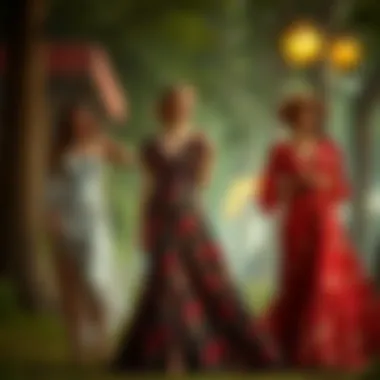

When it comes to vintage long dresses, proper care and maintenance is crucial. These garments carry not only aesthetic appeal but also historical value. Preserving them ensures that future generations can appreciate the artistry and craftsmanship of past eras. Understanding the importance of cleaning and storing vintage fabrics can safeguard their beauty and integrity over time.
Cleaning Guidelines for Vintage Fabrics
Cleaning vintage fabrics can be a delicate affair. Each textile may require unique handling, depending on its composition. Here are some essential tips to keep in mind:
- Check the Care Label: Always look for any attached labels that denote cleaning instructions. These might give insights into how the dress was constructed and what it can withstand.
- Spot Clean First: Before throwing the entire dress into the wash, try spot cleaning with a gentle detergent. This prevents larger stains from setting in.
- Hand Wash Preferred: When in doubt, hand washing is often the safest option. Use lukewarm water mixed with a mild detergent, and be gentle while agitating the fabric.
- Avoid Bleaching Agents: For vintage fabrics, harsh chemicals like bleach can cause irreversible damage. Stick to natural water-based solutions.
- Dry Flat: After washing, lay the garment flat on a clean towel to dry, avoiding direct sunlight which can lead to fading. Hang drying can stretch the fabric, leading to misshapen pieces.
"The care of vintage pieces is not just a task; it's a commitment to history and art."
Storage Techniques to Preserve Quality
Storing vintage long dresses properly is just as important as cleaning them. Here are several techniques that can help:
- Use Cotton or Muslin Bags: Avoid plastic, as it can trap moisture and promote mold. Instead, opt for breathable fabrics like cotton to keep your dresses safe.
- Acid-Free Tissue: When storing, place acid-free tissue paper inside the folds of the dress to prevent creases and maintain shape.
- Cool, Dry Place: Find a storage area that is neither too humid nor too dry. A closet away from windows is often ideal, as it protects from UV rays and fluctuating temperatures.
- Avoid Hangers with Clips: Use padded hangers that support the garment well. Clips can leave marks or even damage the fabric over time.
- Regular Inspections: Every few months, take the dress out to inspect for any signs of damage, pests or problems. Taking a proactive approach will help catch issues before they become major problems.
By taking these steps in cleaning and storing, you will greatly extend the life and appeal of vintage long dresses in your collection. Enjoying these timeless pieces means being attentive to their needs, ensuring they remain a cherished part of your wardrobe for many years to come.
The Economic Impact of Vintage Clothing Markets
In recent years, the vintage clothing market has blossomed into a dynamic and influential sector within the fashion industry. This rise isn't simply a passing fad; it's a robust reflection of shifts in consumer behavior, attitudes toward sustainability, and the overall economic landscape. Vintage long dresses, with their unique charm and history, contribute significantly to this evolving marketplace.
The economic impact of vintage clothing can be viewed through multiple lenses. First, it plays a critical role in driving smaller retail operations, including thrift stores, boutiques, and online platforms specializing in second-hand goods. These venues offer consumers a curated experience while also fostering unique relationships between sellers and buyers. Many designers and fashion enthusiasts find their niche in sourcing vintage garments, thereby bolstering local economies.
Additionally, the demand for vintage fashion stimulates job creation. From sourcing and restoring these cherished pieces to the various roles in retail, marketing, and online sales, the vintage sector generates employment opportunities that support communities at large.
Another important aspect is the investment potential that vintage dresses possess. Unlike fast fashion or mass-produced items, certain vintage long dresses can appreciate in value over time. This brings about a new perspective on consumer buying behavior, where individuals start viewing clothing as an investment rather than just a purchase. The allure of owning a piece of history adds to its value, making collectors and casual buyers alike keen on investing in these timeless pieces.
With the environmental movements gaining traction, many consumers are turning toward vintage as a sustainable alternative. This shift not only promotes the longevity of clothing but encourages responsible consumerism. As people become more conscious of their carbon footprint, they are inclined to seek out vintage options, knowing that they are supporting a more sustainable fashion cycle.
"Investing in vintage is like holding onto a clever piece of the past, and who wouldn't want a slice of history in their wardrobe?"
A Look into Vintage Retail and Online Platforms
The landscape of vintage retail has changed drastically due to digital influence. Once, a vintage hunt required physical card catalogues and flea markets; now, platforms like Etsy, Depop, and eBay have put vintage long dresses at fingertips globally. Online sites reduce geographical barriers, allowing sellers to reach audiences far and wide.
Additionally, many independent boutiques have established an online presence, blending the charm of a physical location with the convenience of e-commerce. This has allowed them to thrive amidst larger retail giants, as consumers appreciate the personalized service and unique finds often provided by small businesses.
Key Aspects of Vintage Online Platforms:
- Global access to unique finds
- Connection between vintage sellers and niche communities
- Opportunities for emerging designers and entrepreneurs
The Value of Vintage Dresses: Investment or Expense?
When it comes to vintage long dresses, the question often arises: are they an investment or an expense? This isn’t a straightforward answer, as the value can swing based on numerous factors. Many buyers tend to view vintage dresses as special treasures, often linked to memory and nostalgia.
To determine whether it’s an investment, one should consider:
- Brand Reputation: Reputable vintage brands tend to hold or increase value.
- Condition: Well-preserved dresses often fetch a higher price when resold.
- Rarity: Limited editions or designer pieces can become valuable assets.
- Trends: Fashion trends ebb and flow; understanding what is currently coveted can enhance investment viability.
Therefore, while the initial purchase might feel substantial, savvy consumers recognize the potential return. Vintage long dresses can serve as a stylish addition that appreciates over time, allowing fashion enthusiasts to enjoy them while also holding wealth in their wardrobes.
As we see the growing affection for vintage shopping, awareness about its economic impact continue to evolve. Recognizing the fragility and beauty within each piece strengthens the rich narrative of fashion history while encouraging tomorrow’s sustainable consumers.
End: The Enduring Fascination with Vintage Long Dresses
As we wrap up our exploration into the realm of vintage long dresses, it becomes apparent that their charm transcends mere aesthetics. These dresses are not just fabric stitched together but are repositories of history, culture, and personality. Each piece tells a story, often echoing the sentiments of the eras from which they emerged.
The allure of vintage long dresses lies primarily in their unique characteristics—not only in the fabrics they are crafted from but in their distinctive cuts and patterns. Unlike contemporary fashions that often feel churned out, these vintage pieces carry an authenticity that resonates with fashion enthusiasts. The tactile experience of wearing these gowns connects one with the past, inviting wearers to immerse themselves in the lifestyle and sentiment of earlier generations.
Another factor fueling this fascination is the current trend toward sustainability in fashion. As the world grapples with the consequences of fast fashion, vintage long dresses emerge as not just a stylish choice but a responsible one. By choosing vintage, individuals participate in a cycle of appreciation and preservation rather than wastefulness. Such choices reflect a broader cultural shift towards valuing quality and craftsmanship over quantity.
"Vintage fashion isn't merely a nod to the past; it is the exploration of identity through the lens of time."
Additionally, integrating vintage long dresses into modern wardrobes provides an opportunity to express individuality. In a society where trends come and go, donning a vintage piece can differentiate a wearer in a sea of mass-produced clothing. These dresses serve as conversation starters, sparking connections among those who admire the artistry involved in their design.
Despite the ongoing evolution of fashion, the vintage long dress remains a steadfast symbol of elegance and grace. Its ability to adapt to the whims of changing styles without losing its identity confirms its rightful place in the annals of fashion history. So whether you are a seasoned collector or merely curious about dipping your toes into the world of vintage, know that these timeless pieces offer more than clothes; they provide a connection to the past, a sustainable future, and a personal narrative waiting to be told.
In summary, vintage long dresses hold a prominent place not only in the wardrobes of fashion aficionados but also in the broader conversation about sustainability, identity, and cultural heritage. Their enduring fascination reflects a balance between nostalgia and contemporary relevance, ensuring that they will forever hold a special spot in the fashion landscape.
For further reading, consider visiting Wikipedia on Vintage Fashion or Britannica's take on Fashion History to deepen your understanding of this topic.


